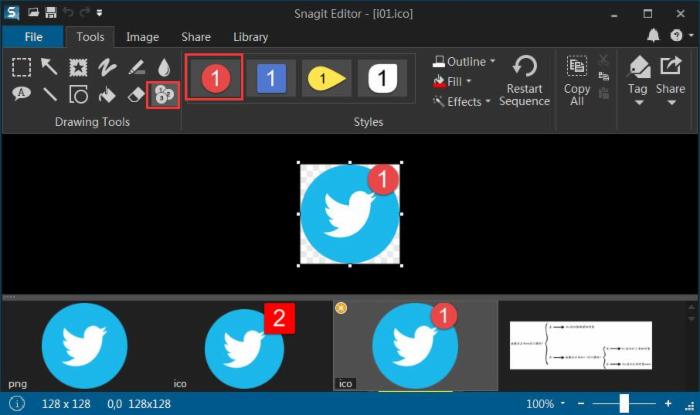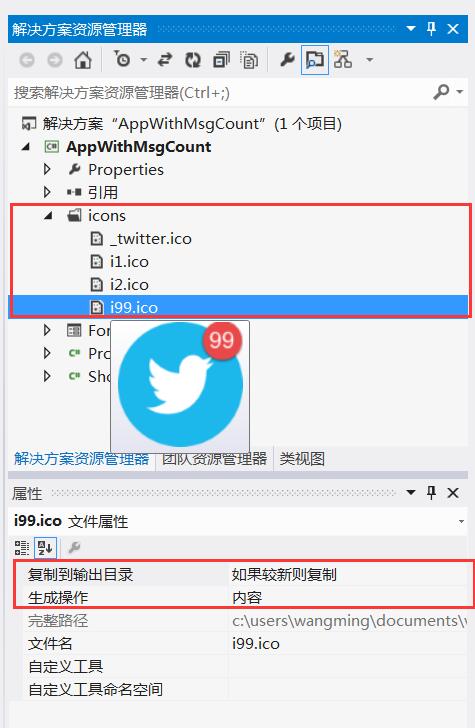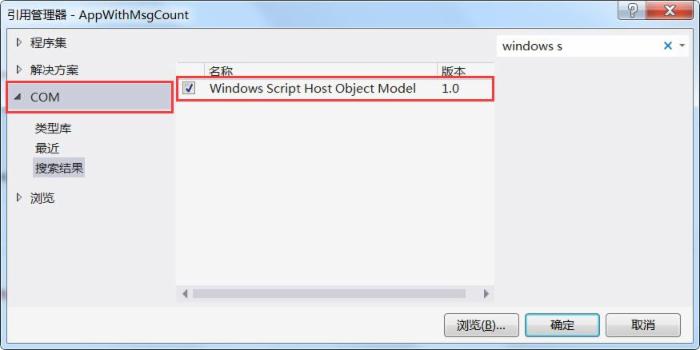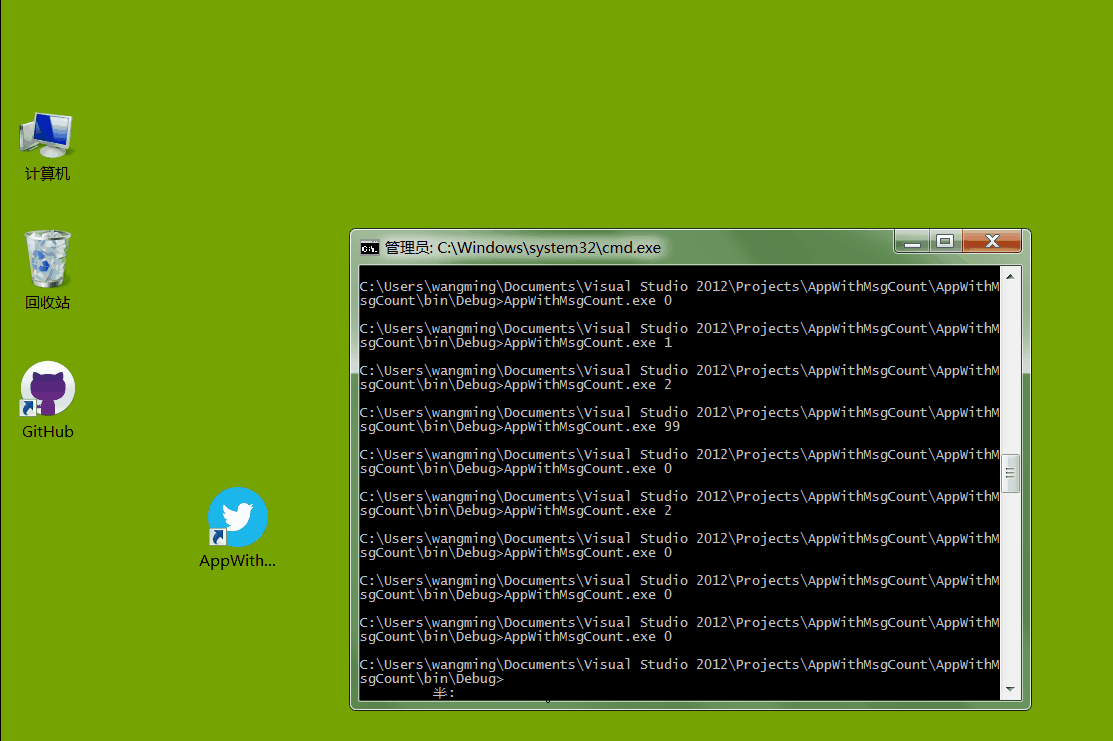如何实现桌面App图标可以动态显示消息数(类似手机上的QQ图标)?
手机上的APP , 像QQ和微信等都可以在图标上动态显示消息数(最大99) , 那么你有没有想过这些效果是如何实现的?桌面上开发的传统应用程序能否也实现类似的功能?
1 思路
- 桌面快捷方式的图标本质上就是基于一个图片产生的 , 第一种是动态生成图标(不过感觉比较费事且也消耗资源) , 建议方式是预先定义从0到99这100个图标(0就是不显示消息数 , >=99的就用99代替);
- 获取用户的未处理消息数(根据业务情况产生 , 这里不是重点 , 直接用一个数值模拟即可);
- 先判断该App桌面图标是否存在,存在先删除,然后根据消息数,到程序指定目录下搜寻对应编号的图标文件 , 赋值到创建桌面图标的方法中即可.
2 图片资源制作
可以找一个透明背景的png图(如果有美工可以进行自行设计 , 我这里用的Twitter的图标) , 然后用Snagit Editor软件打开 , 在图的右上角添加一个数值标注 , 然后另存为ICO格式.如下图所示:

3 项目结构
新建一个C#桌面项目 , 然后创建一个icons文件夹来存放不同编码的图标(演示没必要创建所有 , 有2 到3个作为演示即可) , 值得注意的是 , 一定不要忘了在图标上单击 , 然后在其属性面板中设置将赋值到输出目录 , 否则找不到该图标.

另外就是要引入一个COM库Windows Script Host Object Model , 来帮助我们创建快捷方式.

4 核心代码
直接在默认的Form1窗体加载事件中进行动态图标创建处理 , 看代码:
1 using System; 2 using System.Collections.Generic; 3 using System.ComponentModel; 4 using System.Data; 5 using System.Drawing; 6 using System.Linq; 7 using System.Text; 8 using System.Windows.Forms; 9 using IWshRuntimeLibrary; 10 using System.IO; 11 namespace AppWithMsgCount 12 { 13 public partial class Form1 : Form 14 { 15 public Form1() 16 { 17 InitializeComponent(); 18 } 19 20 private void Form1_Load(object sender, EventArgs e) 21 { 22 //如何去除桌面快捷方式图标箭头 23 //未测试!!!!! cmd /k reg delete "HKEY_CLASSES_ROOT/lnkfile" /v IsShortcut /f & taskkill /f /im explorer.exe & start explorer.exe 24 ShowMsgCountOnIcon(2); 25 26 } 27 /// <summary> 28 /// 显示带消息数目的桌面快捷方式 29 /// </summary> 30 /// <param name="msgNum"></param> 31 /// <returns></returns> 32 private bool ShowMsgCountOnIcon(int msgNum) 33 { 34 try 35 { 36 DeleteShortcut(); 37 // int msgNum = 99; 38 CreateShortcut(msgNum); 39 this.Text = string.Format("您有{0}个消息", msgNum); 40 return true; 41 } 42 catch (Exception ex) 43 { 44 this.Text = string.Format("error:{0}", ex.Message); 45 return false; 46 } 47 finally 48 { 49 50 } 51 } 52 /// <summary> 53 /// 如果之前有快捷方式应该先删除再刷新,否则图标不更新 54 /// </summary> 55 /// <param name="path"></param> 56 /// <param name="iconNum"></param> 57 private static void CreateShortcut(int msgNum) 58 { 59 // using IWshRuntimeLibrary; // > Ref > COM > Windows Script Host Object 60 string link = Environment.GetFolderPath(Environment.SpecialFolder.Desktop) 61 + Path.DirectorySeparatorChar + Application.ProductName + ".lnk"; 62 var shell = new WshShell(); 63 var shortcut = shell.CreateShortcut(link) as IWshShortcut; 64 shortcut.TargetPath = Application.ExecutablePath; 65 shortcut.WorkingDirectory = Application.StartupPath; 66 // string appPath = AppDomain.CurrentDomain.BaseDirectory.ToString(); 67 string fullPath = Application.StartupPath + @"/icons/"; 68 69 shortcut.IconLocation = string.Format("{0}i{1}.ico", fullPath, msgNum.ToString()); 70 //shortcut... 71 shortcut.Save(); 72 73 } 74 /// <summary> 75 /// 删除已有的APP快捷方式 76 /// </summary> 77 private void DeleteShortcut() 78 { 79 var desktop = Environment.GetFolderPath(Environment.SpecialFolder.Desktop); 80 var app = Application.ProductName + ".lnk"; 81 if(System.IO.File.Exists(Path.Combine(desktop, app))) 82 { 83 System.IO.File.Delete(Path.Combine(desktop, app)); 84 } 85 } 86 } 87 } 5 效果
为了演示的效果更好 , 对上面的代码稍作修改 , 让他可以在命令行接受参数 , 动态传入消息数.

1 using System; 2 using System.Collections.Generic; 3 using System.Linq; 4 using System.Windows.Forms; 5 6 namespace AppWithMsgCount 7 { 8 static class Program 9 { 10 /// <summary> 11 /// 应用程序的主入口点。 12 /// </summary> 13 [STAThread] 14 static void Main(String[] args) 15 { 16 Application.EnableVisualStyles(); 17 Application.SetCompatibleTextRenderingDefault(false); 18 if (args == null) 19 { 20 Application.Run(new Form1("99")); 21 } 22 else { 23 if (args.Length == 0) 24 { 25 Application.Run(new Form1("99")); 26 } 27 else 28 { 29 Application.Run(new Form1(args[0])); 30 } 31 } 32 } 33 } 34 } View Code 正文到此结束
热门推荐
相关文章
Loading...











![[HBLOG]公众号](https://www.liuhaihua.cn/img/qrcode_gzh.jpg)

